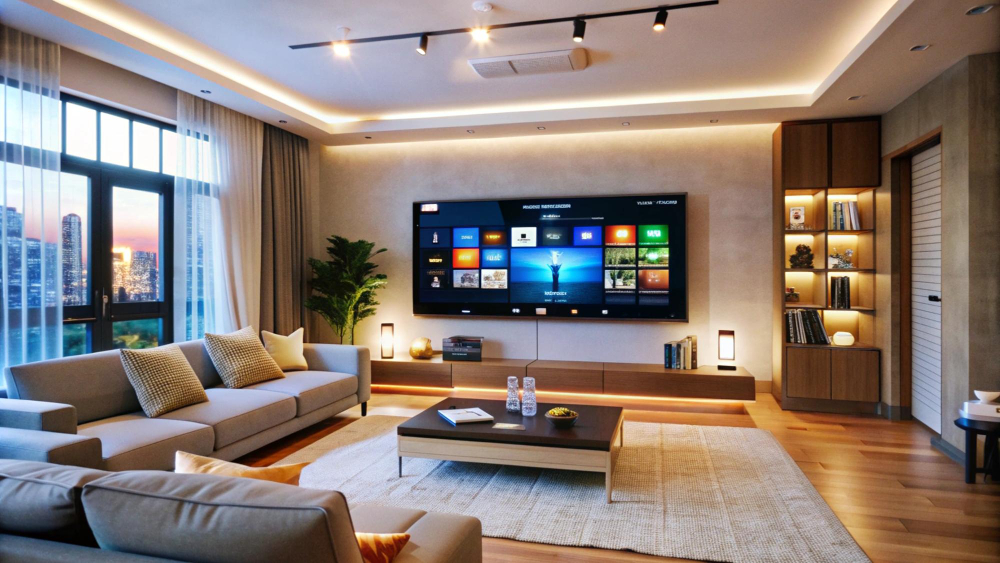A home theater system can bring the cinematic experience into the comfort of your own home, providing immersive sound, sharp visuals, and a space where family and friends can enjoy movies, music, and more. However, before diving into the installation, it’s important to consider several factors to ensure your system delivers the best possible experience. Below are key things to keep in mind before installing a home theater system:
1. Room Size and Layout
The size and layout of the room where you plan to install the home theater will directly impact the type of equipment you should choose. A large room may require more powerful speakers and a larger screen, while a smaller room could benefit from more compact and efficient options.
- Room Shape: Rectangular rooms typically offer better acoustics than square rooms.
- Seating Arrangement: Consider where viewers will sit to ensure they have a clear view of the screen and are in the optimal position to experience surround sound.
2. Acoustic Treatments
Sound quality is as crucial as visual quality in a home theater system, and your room’s acoustics play a major role. Factors such as hard surfaces (walls, floors, ceilings) can cause sound reflections, leading to echoes or poor sound clarity.
- Acoustic Panels: Consider installing acoustic treatments like panels or diffusers on the walls and ceiling to reduce echo and improve sound clarity.
- Carpet or Rugs: Adding soft materials like rugs or carpets can help absorb sound and reduce reflections.
- Furniture Positioning: The placement of furniture can affect the way sound waves travel through the room.
3. Screen Size and Type
Choosing the right screen size is essential for an optimal viewing experience. Too large a screen in a small space can be overwhelming, while too small a screen can diminish the cinematic experience.
- Screen Size: A good rule of thumb is to measure the distance between the screen and the seating area. For 4K displays, the screen size should be about half the viewing distance.
- Type of Display: Decide between a TV or a projector. TVs are more straightforward and work better in brighter rooms, while projectors are great for larger screens and create a more authentic theater feel, especially in darker rooms.
4. Audio Setup
Audio is one of the most vital elements of a home theater system. A true surround sound setup can greatly enhance your viewing experience, but it’s important to select the right equipment.
- Surround Sound: The most common setups are 5.1, 7.1, or 9.1 surround sound systems. The first number refers to the number of satellite speakers, and the second refers to the subwoofer.
- Speaker Placement: For a 5.1 system, you’ll want to place the center speaker directly in front, left and right speakers at ear level, surround speakers slightly behind the seating area, and the subwoofer in a corner for optimal bass distribution.
- Soundbars: If you’re limited on space or budget, a high-quality soundbar can still offer a much better audio experience than TV speakers.
5. Lighting Considerations
Lighting can significantly impact your viewing experience. Too much ambient light can wash out the screen, while too little light can strain your eyes.
- Dim Lighting: Installing dimmable lights or wall sconces allows you to adjust the lighting based on the movie, adding to the theater-like atmosphere.
- Blackout Curtains: If your room has windows, consider installing blackout curtains to prevent natural light from washing out the picture on your screen.
6. Ventilation and Climate Control
Home theater equipment like projectors, receivers, and amplifiers can generate significant heat, especially when running for extended periods. A well-ventilated room will ensure that your equipment does not overheat, prolonging its lifespan and maintaining consistent performance.
- Air Conditioning: Consider air conditioning or good ventilation to keep the room cool.
- Equipment Placement: Ensure that there is sufficient airflow around your electronic devices. Avoid placing them in enclosed cabinets unless proper ventilation is provided.
7. Cable Management
With multiple devices such as speakers, projectors, gaming consoles, and streaming boxes, proper cable management is essential for maintaining a clean and organized setup.
- Pre-Wiring: If possible, pre-wire the room before setting up the equipment, running cables through walls or using cable conduits to keep things neat.
- Wireless Options: Consider wireless speakers and streaming devices to reduce the number of cables, though you may need to compromise on some audio quality.
- Cable Labeling: Labeling your cables can save you a lot of headaches when making adjustments or troubleshooting.
8. Choosing the Right Components
Selecting high-quality components ensures you get the best performance for your budget. Some essential components of a home theater system include:
- Receiver: The receiver is the hub of your home theater system, responsible for processing audio and video signals and sending them to the appropriate devices.
- Speakers: Look for speakers that match the size of your room and your desired audio performance.
- Subwoofer: A good subwoofer will add depth to your sound, making action scenes more intense and music more immersive.
- Projector/TV: Choose between a 4K TV or a 4K projector based on your room’s lighting and size.
9. Smart Home Integration
Many modern home theater systems can be integrated with smart home systems, allowing you to control everything from lighting and sound to the screen itself with a voice command or mobile app.
- Automation: You can set up automation for dimming lights when a movie starts or adjusting sound levels based on the type of content you’re watching.
- Voice Control: Integration with voice assistants like Alexa or Google Home can make controlling your home theater more convenient.
10. Budgeting for the Installation
The cost of a home theater system can vary widely based on the equipment, room size, and installation complexity. It’s important to set a budget that covers not only the hardware but also professional installation, if necessary.
- Hidden Costs: Consider the cost of cabling, mounts, seating, and other accessories in your budget.
- Professional vs. DIY Installation: While some aspects of a home theater system can be set up DIY-style, more complex installations, especially those involving in-wall wiring and acoustic treatments, may require a professional installer.
11. After-Sales Support
Finally, ensure that you have access to reliable after-sales support for maintenance, repairs, or technical support. This can save you from potential headaches if anything goes wrong with your system.


